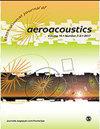Initial boundary layer state of typical model-scale jet nozzles and its impact on noise
IF 1.3
4区 工程技术
Q3 ACOUSTICS
引用次数: 0
Abstract
A set of 2-inch diameter nozzles is used to investigate the effect of varying exit boundary layer (BL) states on the radiated noise from high-subsonic jets. It is confirmed that nozzles involving turbulent boundary layers are the quietest while others, involving nominally-laminar BLs, are noisier. A turbulent BL is thicker and there is simply an effect of thickness on noise. A thicker BL results in a decrease in the sound pressure spectral amplitudes due to a less vigorous growth of instability waves in the jet’s shear layer. A nominally-laminar BL, besides being thinner, may also involve significantly higher turbulence intensities, much higher than that in a turbulent BL. Such a BL state, referred to as ‘highly disturbed laminar’, results in the largest noise amplitudes especially on the high-frequency side of the spectrum. This transitional state, often encountered with model scale nozzles, involves a ‘Blasius-like’ mean velocity profile but large velocity fluctuation intensities and intermittency. The higher initial turbulence adds to the increase in high-frequency noise. The results leave little doubt that an anomaly noted with subsonic jet noise databases in the literature is due to similar effects of differences in the initial boundary layer state.典型模型尺度喷管初始边界层状态及其对噪声的影响
采用一组直径为2英寸的喷嘴,研究了不同出口边界层状态对高亚音速射流辐射噪声的影响。经证实,涉及湍流边界层的喷嘴是最安静的,而其他涉及名义层流BLs的喷嘴噪音更大。湍流边界层较厚,厚度对噪声有简单的影响。由于射流剪切层中不稳定波的增长较弱,较厚的边界层导致声压谱幅值降低。名义上的层流边界层除了更薄之外,还可能涉及明显更高的湍流强度,比湍流边界层高得多。这种边界层状态被称为“高度扰动层流”,导致最大的噪声幅值,特别是在频谱的高频侧。这种过渡状态经常在模型规模的喷嘴中遇到,涉及“类似blasius”的平均速度剖面,但速度波动强度大且间歇性。较高的初始湍流增加了高频噪声的增加。结果表明,文献中亚音速射流噪声数据库记录的异常是由于初始边界层状态差异的类似影响。
本文章由计算机程序翻译,如有差异,请以英文原文为准。
求助全文
约1分钟内获得全文
求助全文
来源期刊

International Journal of Aeroacoustics
ACOUSTICS-ENGINEERING, AEROSPACE
CiteScore
2.10
自引率
10.00%
发文量
38
审稿时长
>12 weeks
期刊介绍:
International Journal of Aeroacoustics is a peer-reviewed journal publishing developments in all areas of fundamental and applied aeroacoustics. Fundamental topics include advances in understanding aeroacoustics phenomena; applied topics include all aspects of civil and military aircraft, automobile and high speed train aeroacoustics, and the impact of acoustics on structures. As well as original contributions, state of the art reviews and surveys will be published.
Subtopics include, among others, jet mixing noise; screech tones; broadband shock associated noise and methods for suppression; the near-ground acoustic environment of Short Take-Off and Vertical Landing (STOVL) aircraft; weapons bay aeroacoustics, cavity acoustics, closed-loop feedback control of aeroacoustic phenomena; computational aeroacoustics including high fidelity numerical simulations, and analytical acoustics.
 求助内容:
求助内容: 应助结果提醒方式:
应助结果提醒方式:


